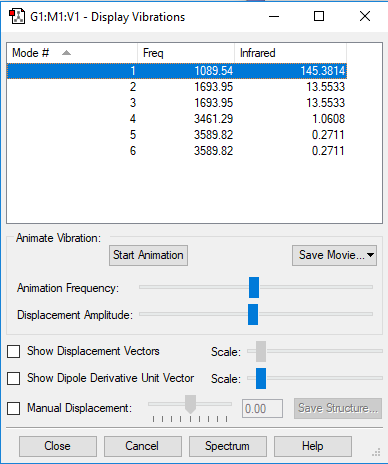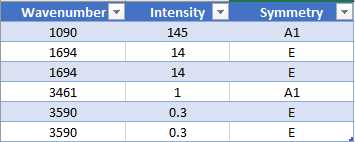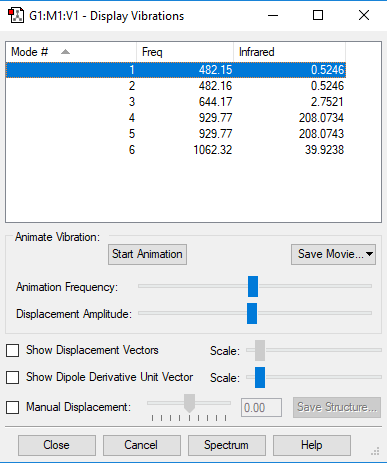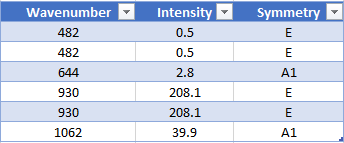Rep:Mod:TI1918
NH3
Calculation Method: RB3LYP
Basis Set: 6-31G(d,p)
Final Energy: -56.558 a.u
RMS Gradient: 0.00000485 a.u
Point Group: C3V
Bond Angle: 105.741° accurate to 1°
Bond Length: 1.3Å accurate to 0.001Å
Item Value Threshold Converged?
Maximum Force 0.000004 0.000450 YES
RMS Force 0.000004 0.000300 YES
Maximum Displacement 0.000072 0.001800 YES
RMS Displacement 0.000035 0.001200 YES
Predicted change in Energy=-5.986296D-10
test molecule |
Link: File:TIMPERATO NH3 OPTF POP.LOG
I expect 6 nodes considering the 3N-6 rule. There are two pairs of degenerate vibrations (with wavenumber 1694, 3590) and two non-degenerate vibrations. There are three bending (with wavenumber 1694, 1090) and three stretching (with wavenumber 3590, 3461). The vibration of wavenumber 3461 is the most symmetrical. The vibratiion of wavenumber 1090 is known as the "umbrella" mode. I would expect to see four bands in the experimental spectrum.
The charge of the central Nitrogen atom is -1.125 and the charge of the Hydrogen atom is +0.375. This is expected as the Nitrogen atom is more electronegative than the hydrogen so it attracts the electron density of the covalent bonds more so towards itself.
H2
Calculation Method: RB3LYP
Basis Set: 6-31G(d,p)
Final Energy: -1.179 a.u
RMS Gradient: 0.00000017 a.u
Point Group: D*H
Bond Angle: 180° accurate to 1°
Bond Length: 0.74279Å accurate to 0.001Å
Item Value Threshold Converged? Maximum Force 0.000000 0.000450 YES RMS Force 0.000000 0.000300 YES Maximum Displacement 0.000000 0.001800 YES RMS Displacement 0.000001 0.001200 YES Predicted change in Energy=-1.164080D-13
test molecule |
Link: File:TIMPERATO H2 OPTF POP.LOG
The charge on each hydrogen atom in the molecule is 0.
N2
Calculation Method: RB3LYP
Basis Set: 6-31G(d,p)
Final Energy: -109.524 a.u
RMS Gradient: 0.00220 a.u
Point Group: D*H
Bond Angle: 180° accurate to 1°
Bond Length: 1.104Å accurate to 0.001Å
Item Value Threshold Converged? Maximum Force 0.000001 0.000450 YES RMS Force 0.000001 0.000300 YES Maximum Displacement 0.000000 0.001800 YES RMS Displacement 0.000000 0.001200 YES Predicted change in Energy=-3.401036D-13
test molecule |
Link: File:TIMPERATO N2 OPTF POP.LOG
The charge on each Nitrogen atom is 0.
N2 is found coordinately bonded to a mono-metallic transition complex - AQEZIH
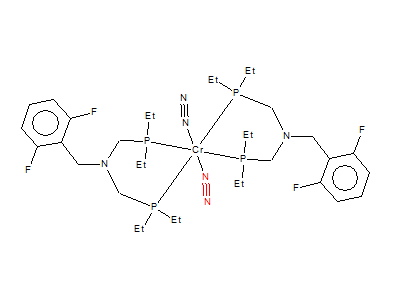
There is a N-N bond distance of 1.127Å in the transition complex where as it is 1.104Å in the simple molecule. This difference is due to the fact that the positively charged metal pulls the partially negative Nitrogen atom towards the centre and therefore elongating the bond distance in the crystal structure compared to the simple molecule. Also there is always error in computational calculations and therefore a slight difference in results to experimental results can be expected and is virtually unavoidable.
Energy Calculation
Energy of NH3 = -56.55777 a.u
2 * Energy of NH3 = -113.11554 a.u
Energy of H2 = -1.12854 a.u
3 * Energy of H2 = -3.38562 a.u
Energy of N2 = -109.52359 a.u
Change in energy of reaction = -0.20633 a.u
Enthalpy Change Of Reaction = -541.7 KJ/mol
The ammonia product is more stable than the gaseous reactants as the enthalphy change is negative and therefore the reaction is exothermic.
NF3
Calculation Method: RB3LYP
Basis Set: 6-31G(d,p)
Final Energy: -354.07131 au
RMS Gradient: 0.00010257 au
Point Group: C3V
Bond Angle: 101.830° accurate to 1°
Bond Length: 1.384Å accurate to 0.001Å
Item Value Threshold Converged? Maximum Force 0.000164 0.000450 YES RMS Force 0.000108 0.000300 YES Maximum Displacement 0.000613 0.001800 YES RMS Displacement 0.000296 0.001200 YES Predicted change in Energy=-1.274236D-07
test molecule |
Link: File:TIMPERATO NF3 OPTF POP.LOG
The central Nitrogen atom has a charge of +0.660 where as the Fluorine atoms have a charge of -0.220.
Molecular Orbitals
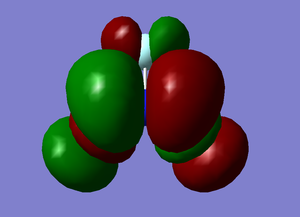
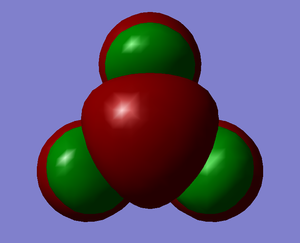
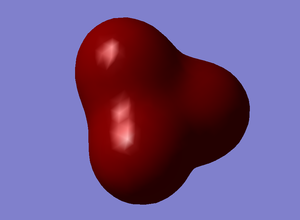
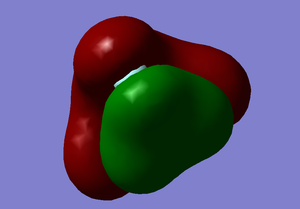
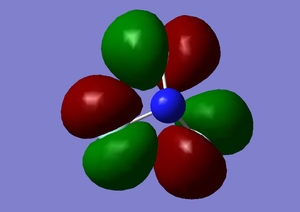
Figure 1: This molecular orbital is the LUMO and therefore will be heavily involved within reactions, it has an energy of 0.01947 a.u. It is an antibonding orbital that is fully unoccupied and it allows the molecule to be attacked by nucleophiles which may in turn lead to a change in bond arrangement and a reaction mechanism.
Figure 2: This diagram represents the HOMO orbital of the molecule and is also significantly important in reactions as it works in tandem with the LUMO during electrophile-nucleophile reactions. It has an energy of -0.35162 a.u and has a mixture of bonding and antibonding character.
Figure 3: The molecular orbital is fully bonding due to consistent overlap between s orbitals of all 4 atoms in the molecule. It won't be involved in reactions even though it is occupied as it is too close to the centre of the molecule and is quite energetic with -1.35870 a.u.
Figure 4: This is the 11th most energetic orbital and is a mixture of antibonding and bonding character. It is fully occupied and it is unlikely to be involved in reactions as the electrons are too central and it has an energy of -0.57102 a.u.
Figure 5: The 2nd least energetic occupied orbital is fully antibonding in character due to repulsion and zero overlap. It is likely to be used in reactions as it is in the outer shell and is low in energy with -0.42224 a.u. It is made up of 3 p orbitals and 1 s orbital.
Marking
Note: All grades and comments are provisional and subject to change until your grades are officially returned via blackboard. Please do not contact anyone about anything to do with the marking of this lab until you have received your grade from blackboard.
Wiki structure and presentation 0.5/1
Is your wiki page clear and easy to follow, with consistent formatting?
YES
Do you effectively use tables, figures and subheadings to communicate your work?
YES - however you have left the default jmol caption "test molecule" as the caption for all your jmols, which is unhelpful for a reader.
NH3 0.5/1
Have you completed the calculation and given a link to the file?
YES
Have you included summary and item tables in your wiki?
YES
Have you included a 3d jmol file or an image of the finished structure?
YES
Have you included the bond lengths and angles asked for?
YES
Have you included the “display vibrations” table?
YES
Have you added a table to your wiki listing the wavenumber and intensity of each vibration?
YES
Did you do the optional extra of adding images of the vibrations?
YES
Have you included answers to the questions about vibrations and charges in the lab script?
YES - In general these are answered correctly well done. However there are only 2 visible peaks in the spectra of NH3, due to the low intensity of the other 2 peaks. (See infrared column in vibrations table.)
N2 and H2 0/0.5
Have you completed the calculations and included all relevant information? (summary, item table, structural information, jmol image, vibrations and charges)
YES However you have given a bond angle of 180 for N2 and H2, there are no bond angles in diatomic molecules. Bond angles involve exactly 3 atoms.
Crystal structure comparison 0/0.5
Have you included a link to a structure from the CCDC that includes a coordinated N2 or H2 molecule?
You have included the identifier but not referenced/linked properly to the structure.
Have you compared your optimised bond distance to the crystal structure bond distance?
YES
Haber-Bosch reaction energy calculation 0.5/1
Have you correctly calculated the energies asked for? ΔE=2*E(NH3)-[E(N2)+3*E(H2)]
No - you've used a different energy for H2 than the one reportedly earlier in your wiki which was correct.
Have you reported your answers to the correct number of decimal places?
YES
Do your energies have the correct +/- sign?
YES
Have you answered the question, Identify which is more stable the gaseous reactants or the ammonia product?
YES
Your choice of small molecule 3.5/5
Have you completed the calculation and included all relevant information?
YES
Have you added information about MOs and charges on atoms?
YES - you have included basic information. To do better you could have explained the charges in terms of electronegativities, and added more information about the contribution of AOs to form the MOs.
Independence 0/1
If you have finished everything else and have spare time in the lab you could: Check one of your results against the literature, or Do an extra calculation on another small molecule, or Do some deeper analysis on your results so far

